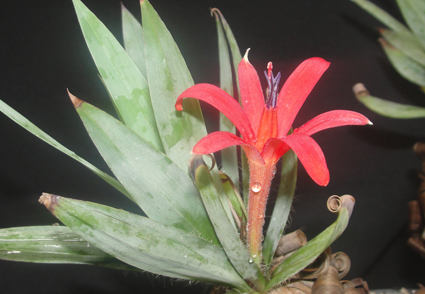Abstract
Two new species of Barbacenia (Velloziaceae) from the Brazilian campo rupestre from the southern part of the Espinhaço Range are here described and illustrated. Both new species, Barbacenia glaucescens Ferreira-Junior & Andr.Cabral sp. nov. and B. mellosilvae Andr.Cabral & Ferreira-Junior sp. nov., resemble B. gentianoides Taub. ex Goethart & Henrard, and the second one also resembles B. longiflora Mart. However, both can be differentiated by a unique combination of morphological and anatomical characters. Morphological and anatomical descriptions, illustrations, photographs, phenological information, provisional risk assessments, distribution map, and taxonomic notes are provided for the new species.
References
- Assis, L.C.S. & Brigandt, I. (2009) Homology: homeostatic property cluster kinds in systematics and evolution. Evolutionary Biology 36: 248–255. https://doi.org/10.1007/s11692-009-9054-y
- Bachman, S., Moat, J., Hill, A.W., Torre, J. & Scott, B. (2011) Supporting Red List threat assessments with GeoCAT: geospatial conservation assessment tool. ZooKeys 150: 117–126. https://doi.org/10.3897/zookeys.150.2109
- Behnke, H.D., Hummel, E., Hillmer, S., Sauer‐Gürth, H., Gonzalez., J. & Wink, M. (2013) A revision of African Velloziaceae based on leaf anatomy characters and rbcL nucleotide sequences. Botanical Journal of the Linnean Society 172: 22–94. https://doi.org/10.1111/boj.12018
- BFG (2021) Brazilian Flora 2020: Leveraging the power of a collaborative scientific network. Taxon: 1–21. https://doi.org/10.1002/tax.12640
- Cabral, A., Magri, R.A. & Lopes, J.D.C. (2021) Vellozia inselbergae (Velloziaceae), a new species from the Brazilian Atlantic Forest inselbergs. Phytotaxa 497 (2): 138–146. https://doi.org/10.11646/phytotaxa.497.2.6
- Gualtieri-Pinto, L., de Oliveira, F.F., Andrade, M.A., Pedrosa, H.F., de Santana, W.A. & Figueiredo, M.A. (2008) Atividade erosiva em trilhas de unidades de conservação: Estudo de caso no Parque Nacional da Serra do Cipó, Minas Gerais, Brasil. e-Scientia 1 (1).
- Henrard, J.T. (1937) Velloziaceae americanae nonnulae novae vel minus cognitae. Blumea 2: 339–384.
- IUCN (2012) IUCN Red List Categories and Criteria. Version 3.1. Second edition. Gland, Switzerland and Cambridge.
- Martius, C.P.F. (1823) Nov. Gen. Sp. Pl. 1: 19.
- Mello-Silva, R. (1991) The infra-familial taxonomic circumscription of the Velloziaceae: a historical and critical analysis. Taxon 40: 45–51. https://doi.org/10.2307/1222921
- Mello-Silva, R. (2005a) Velloziaceae. In: Wanderley, M.G.L., Shepherd, G.J., Melhem, T.S. & Giulietti, A.M. (Eds.) Flora Fanerogâmica do Estado de São Paulo, Vol. 4. FAPESP, Rima, São Paulo, pp. 371–376.
- Mello-Silva, R. (2005b) Morphological analysis, phylogenies and classification in Velloziaceae. Botanical Journal of the Linnean Society 148: 157–173. https://doi.org/10.1111/j.1095-8339.2005.00399.x
- Mello-Silva, R. & Menezes, N.L. (1999) Two new Brazilian Velloziaceae, Vellozia auriculata and Vellozia gigantea, and a key to the related dracenoid species of Vellozia. Novon: 536–541. https://doi.org/10.2307/3392159
- Mello-Silva, R. & Cabral, A. (2022) Taxonomic revision of Barbacenia (Velloziaceae) Atlantic Forest Inselberg group, with two new species. Annals of the Missouri Botanical Garden 107: 32–63. https://doi.org/10.3417/2022685
- Mello-Silva, R., Santos, D.Y.A., Salatino, M.L.F., Motta, L.B., Cattai, M.B., Sasaki, D., Lovo, J., Pita, P.B., Rocini, C., Rodrigues, C.D., Zarrei, M. & Chase, M.W. (2011) Five vicariant genera from Gondwana: the Velloziaceae as shown by molecules and morphology. Annals of botany 108: 87–102. https://doi.org/10.1093/aob/mcr107
- Menezes, N.L. (1980) Nova espécie e novas combinações no gênero Pleurostima Raf. (Velloziaceae). Boletim de Botânica da Universidade de São Paulo 8: 65–69. https://doi.org/10.11606/issn.2316-9052.v8i0p65-69
- Menezes, N.L., Mello-Silva, R. & Mayo, S.J. (1993) A cladistic analysis of the Velloziaceae. Kew Bulletin 49: 71–92. https://doi.org/10.2307/4110200
- Porembski, S. (2007) Tropical inselbergs: habitat types, adaptive strategies and diversity patterns. Brazilian Journal of Botany 30: 579–586. https://doi.org/10.1590/S0100-84042007000400004
- QGIS Development Team (2020) QGIS geographic information system. Ver. 3.16. Open Source Geospatial Foundation Project. Available from: https://qgis.org (accessed 10 February 2020)
- Ribeiro, K.T., Filippo, D.C., Paiva, C.D.L., Madeira, J.A. & Nascimento, J.D. (2005) Ocupação por Brachiaria spp. (Poaceae) no Parque Nacional da Serra do Cipó e infestação decorrente da obra de pavimentação da rodovia MG-010 na APA Morro da Pedreira. Minas Gerais. Simpósio Brasileiro de Espécies Exóticas Invasoras 1: 1–17.
- Ribeiro, K.T. & Freitas, L. (2010) Impactos potenciais das alterações no Código Florestal sobre a vegetação de campos rupestres e campos de altitude. Biota Neotropica 10 (4): 239–246. https://doi.org/10.1590/S1676-06032010000400029
- Rieppel, O. (2007) Species: kinds of individuals or individuals of a kind. Cladistics 23: 373–384. https://doi.org/10.1111/j.1096-0031.2007.00152.x
- Smith, L.B. (1962) A synopsis of the American Velloziaceae. Contributions from the United States National Herbarium 35: 251–292, pl. 1–12.
- Smith, L.B. & Ayensu, E.S. (1976) A revision of American Velloziaceae. Smithsonian Contributions to Botany 30: 1–172. https://doi.org/10.5479/si.0081024X.30
- Thiers, B. (2022) Index herbariorum: a global directory of public herbaria and associated staff. New York Botanical Garden’s Virtual Herbarium. Available from: http://sweetgum.nybg.org/ih/ (accessed 9 May 2022)


